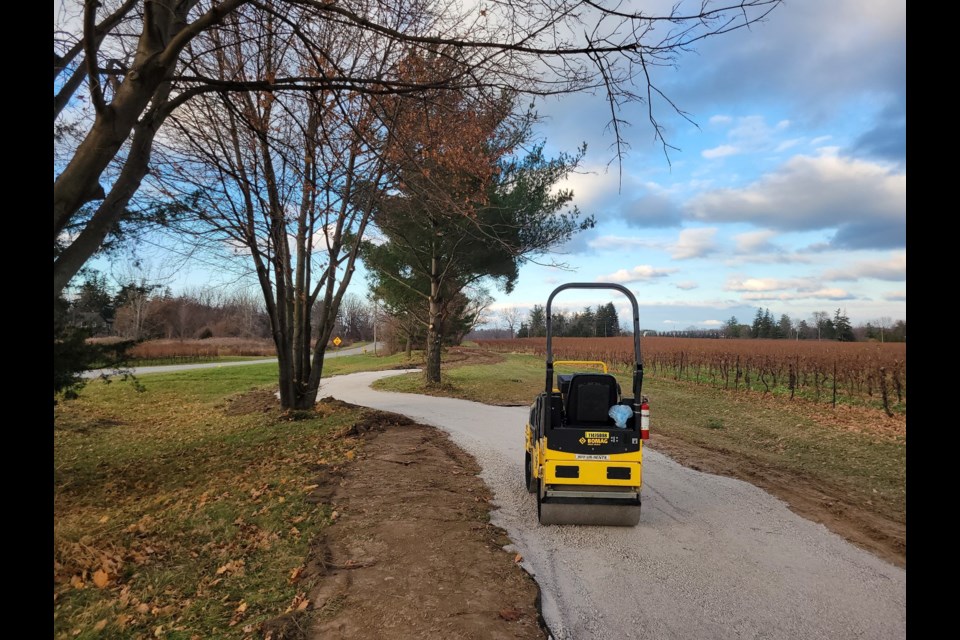Work on Niagara-on-the-Lake's Upper Canada Heritage Trail is on the right path, the town committee overseeing its reconstruction has been told by staff.
Parks and recreation manager Kevin Turcotte said at a recent trail meeting that work from East and West Line to Line 1 is mostly complete, with costs adding up to nearly $36,000 so far.
“The next few sections will go a little easier,” he said, noting they are straighter than the one just finished, and that screenings and shouldering work will take place in the spring.
Signage will be erected on that stretch of path soon, Turcotte said, adding the most recently completed area of trail is 870 metres.
The next two stages, continuing to Line 2 and to Line 3, are both about 810 metres.
Work on these sections should be “more economical,” given they are shorter, said Turcotte.
The first phase, from John Street to East and West Line, cost about $118,000.
The committee currently has about $110,000 in its possession, $50,000 from fundraising efforts and another $60,000 from a grant, said vice-chair Tony Chisholm.
In an interview after the committee meeting, Chisholm said there is no specific target related to the next effort in fundraising.
The committee is "regrouping" now that phase two is underway, he said, adding that the $110,000 the group currently has to work with is sufficient for now, before more fundraising work takes place this year.
"That will finish off phase two and give us a little bit to start phase three," said Chisholm.
Richard Coyne also raised a recent opportunity he learned of – a group called Land Care Niagara, who has reached out and said they could provide bed boxes for plantings along the trail.
Turcotte said it’s a “great offer,” but cautioned the committee that any planting beyond trees and pollinator gardens already laid out in the plans should be held off on until feedback from the public is sought next.
Additional trees and gardens that were not included in the public engagement process that has already occurred could raise concerns, according to Turcotte.
“I don’t want to get us in a challenging situation where people say ‘oh, you didn’t say you were doing that.”
He said when the committee reaches out to residents for feedback when phase three is set to begin, enhancements such as trees and gardens along the completed second phase of the trail can be presented.
The subject of a council resolution, announced after a closed-session meeting two weeks ago, was also discussed briefly. The resolution recommended that an access to The Rand Estate over the trail be explored, and that suggestion was raised by committee vice-chair Tony Chisholm, who said he was looking for more details about the possibility. The access over the trail is to provide developer Benny Marotta an option that would allow for more units than the road into the subdivision currently shown on his application allows. “We have no information on this whatsoever,” said Chisholm.
Parks and recreation director Kevin Turcotte said he would find out how the trail committee can be part of the process as it continues.
This satisfied Chisholm. “We all agree that we’d like to be involved,” he said. “We want to make sure the trail isn’t compromised in any way.”
He told The Local this week that committee members have had no further discussion since then.
Restoration of the trail, more than 10 kilometres long, is being funded entirely by fundraising efforts.
The trail was established to follow the railroad corridor of the Erie and Ontario Railway linking Niagara-on-the-Lake, the first capital of Upper Canada, with Niagara Falls and the Great Western Railway, reads the fundraising group’s website.
When operations began in 1854 it was one of the first steam-powered railroads in Canada West, the new name for Upper Canada.
Rail operations ceased in the mid-1950s, with the corridor being formally abandoned in 1969. For 50 years, the trail has been used by cyclists, equestrians, runners, walkers, cross-country skiers, and others.
